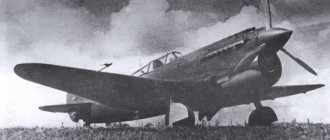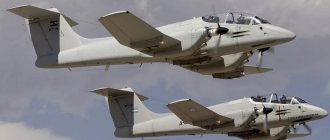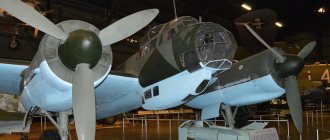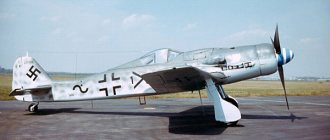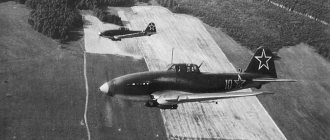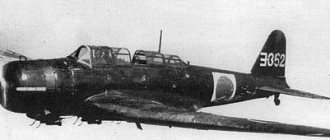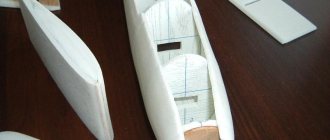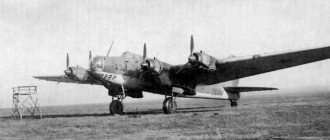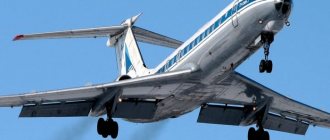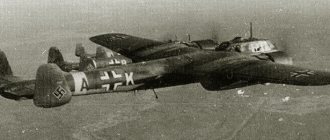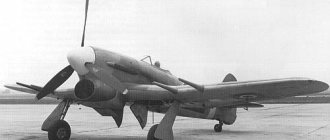Although 1937 was a triumphant year for the Do-17, the Dornier designers were well aware that in order to maintain their position in the bomber market, it would be necessary to offer a new design with even better performance characteristics in the very near future. The design of the aircraft, designed to replace the new product, began to be developed in the summer of 1937 on a proactive basis. The main requirement for the new vehicle was to increase the combat load and flight range, as well as to ensure ease of production and technological continuity with the Do 17. The airframe of the new vehicle, designated Dornier Do-217, was slightly enlarged compared to the Do 17. The designers retained those from its predecessor the general design of the high-wing aircraft, they abandoned the “fairs” at the junction of the wing and fuselage, believing that new, more powerful engines would more than compensate for some deterioration in aerodynamics. It was possible to install four different types of engines, depending on which ones were available.
Luftwaffe bomber Dornier Do-217M
Initially, the new Dornier project did not arouse much interest from the Reich Ministry of Aviation. But in July 1938, the company received a proposal to create a shore-based bomber, optimized for attacks on sea targets from a shallow dive. To do this, the designers used the aerodynamic brake of the Arado system - a kind of four-petal umbrella in the rear part of the fuselage. 14-cylinder air-cooled BMW 139 engines (1550 hp) were chosen as the power plant, and the mass of the bomb load was supposed to be 1500 kg.
Work on the creation of the Dornier Do-217 was carried out quite quickly. The Do-217V1 prototype with DB 601A engines (BMW 139 were not yet ready) was flown on October 4, 1938, but a week later it crashed. On November 5, testing of the Do-217V2 began, and at the beginning of 1939, the Do-217V3 and V4. Since new engines were still being developed, in 1939-1940. built small batches of Do-217A-0 reconnaissance aircraft (with DB 601A engines) and Do-217C-0 bombers (with Jumo 211B). When the tests of the BMW 139 ended in failure, a new BMW 801A engine was chosen for the Do-217.
The first prototype with such engines - the Do-217V8 - entered testing on March 21, 1940. Production of pre-production aircraft began in October 1940. Until the fall of 1943, approximately 1,550 aircraft of the Do-217 bomber modifications were manufactured - in addition to them, Do night fighters were also built 217J and Do-217N.
Technical characteristics of the Do-217E-2 aircraft
- Engine type: BMW 801 ML
- Takeoff power, hp: 1580
- Wingspan, m: 19.15
- Aircraft length, m: 17.22
- Aircraft height, m: 5
- Wing area, sq. m.: 56.6
- Weight, kg:
- empty aircraft: 8840
- takeoff: 15,000
- Maximum speed, km/h: 515
- Rate of climb, m/s: 6.0
- Climb time, min:
- 1000 m - 4.5
- 3000 m - 13.0
- Ceiling, m.: 7500
- Flight range, km:
- Maximum: 2300
- with maximum bomb load: 450
Night fighter
Dornier
Even at the very beginning of the war, it was recognized that the best aircraft suitable for offensive and defensive missions of fighter aircraft was the Ju88 - a durable and stable aircraft capable of carrying devastating small arms, with excellent flight characteristics and flight duration necessary for long-distance raids behind enemy lines. and patrolling. Unfortunately, for night groups of night fighters, this aircraft was required in large quantities for other purposes, and by the end of 1940. The Luftwaffe received only 62 Ju 88C-2 fighters out of a total of 2,184 Ju 88s built that year. Kammhuber, who had been promoted to major general and commander of night fighter aircraft on 16 October 1940, petitioned in vain for the Ju88 to be assigned to night fighter groups, but the situation did not improve. In 1941, of the 2,619 aircraft of this type accepted by the Air Force, only 66 were assembled as fighters, and most of them ended up in heavy fighter squadrons. Even in 1942, when 3,094 Ju88s rolled off the assembly lines in one year, only 257 were built as fighters, and few were equipped for night operations.
And then the Do 17 and Do 215B gave way to the Do 217 heavy bomber. Although the applicability of the heavy bomber as a basis for creating a night fighter was in question, the Dornier project, proposed in early 1941, had some advantages. The improvised fighter was based on the Do 217E-2. Despite its size and weight, the Do 217 was relatively maneuverable, but somewhat under-armed in terms of thrust. It had flight characteristics acceptable for an "offensive" night fighter - it had a more than satisfactory flight duration, which could be further increased by using bomb bays for additional fuel, and could carry powerful weapons. Although it was not an ideal basis for a fighter, due to the lack of sufficient supplies of the coveted Ju 88 it could at least be a fairly decent transition aircraft. The Dornier project to convert the Do 217E-2 was accepted along with a parallel proposal to develop a future version with DB 603A engines in both bomber and night fighter versions.
Do 217J-1
The first version of the converted Do 217E-2 bomber was given the name Do 217J-1. It was specifically designed for raids over enemy territory, retaining a rear bomb bay that could accommodate eight 50 kg SC50X bombs. The front compartment was occupied by an additional tank of 1160 liters, bringing the standard internal fuel supply to 2960 liters. The nose cone was redesigned and lengthened to accommodate four 7.92 mm MG 17 machine guns with 1,000-round magazines. The forward fuselage was also redesigned to accommodate four 20 mm MG FF-M cannons, located in two pairs under the cockpit. The top pair was shifted to the starboard side. An ammunition supply of 350 rounds per barrel was provided. The upper turret with an electric drive, in which a 13-mm MG 131 machine gun was mounted with a supply of 500 rounds, and a machine gun in the ventral ledge with a supply of 1000 rounds were preserved.
On 12 October 1941, shortly before the prototype Do 217J-1 fighter began flight testing, the Führer issued a decree banning further night fighter operations over Britain. Since the original offensive mission for which the aircraft was conceived was replaced by a defensive one before the prototype had even flown, the focus of further development was shifted from the Do 217J-1 to the radar-equipped Do 217J-2, which could not be used for offensive purposes. The factory conversion of the Do 217E-2 to the Do 217J-1 had already reached its final stages when the Fuhrer's decree appeared. However, these vehicles were delivered as J-1s because the Liechtenstein radars needed to convert them into J-2s were not received due to the fact that BfllO production had priority in their delivery.
Combat testing of the Do 217J-1 began in March 1942 at II/NJG1 in Gilse-Rheen. The large night fighter, the largest in service at the time, was compared unfavorably by pilots of No. 4 Squadron to the Do 215B-5 due to its high wing loading and poor take-off performance of the engines, which were said to seriously limit numbers sites from which the Do 217 could be safely operated. Since the Dornier night fighter was no longer intended for raids on the enemy, the advantages that its long flight duration gave it were now of purely academic interest. The Himmelbett night air defense system did not require a long flight duration from the fighters used in it, but clearly desired greater speed and maneuverability than those possessed by the Do 217.
“Himmelbett” or “four-layer” (the name reflected the four components of the system - the Freya early warning radar, two control radars "Wurzburg" and the tablet table "Seeburg") was a system of sectors, the radius of which was determined by the tracking range of the Wurzburg station, tracking behind invading aircraft and directing fighters to targets inside the sector. Poorly suited for operating in the Himmelbett system, the Do 217J-2 accordingly received low priority in the supply of the A1 radar and other equipment.
The small number of Do 217J-1s supplied to the Luftwaffe were used primarily for training purposes. Do 217J-2s began to reach combat units in the summer of 1942, when the Luftwaffe command began to attach increasing importance to German night air defense. The great efforts of RAF Bomber Command meant that night raids saw the slow and poorly armed twin-engine bombers replaced by much more powerful heavy aircraft such as the Lancaster, which made its debut over Germany on the night of 10/11. March 1942. A month later, the first 3,629 kg bomb was dropped on Essen. All doubts about the importance of night fighter aircraft were dispelled on the night of 30–31 May, when the British launched Operation Millennium, the first "thousand bomber raid" targeting Cologne.
Do 217J-2
The Do 217J-2 differed from its predecessor only in the absence of a rear bomb bay and the fact that a Liechtenstein Air Force with its Matratzen antenna was mounted in the nose. Having a dry weight with equipment of 9350 kg and a normal loaded weight of 13180 kg, the Do 217J-2 was actually only slightly heavier than the fighter version of the Ju88, but two 14-cylinder star-shaped air-cooled BMW801ML engines, which produced 1580 hp at takeoff. s., and at an altitude of 4600 m - 1380 l. s., could not give the required thrust-to-weight ratio, and the maximum speed at 5500 m was only 489 km/h.
Combat use.
Although 157 Do 217 night fighters had been assembled by the end of 1942, reports from the Luftwaffe Chief of Staff reported that only 55 of them were used in combat, mainly due to difficulties in supplying the necessary equipment for night operations, including the Liechtenstein radar, which was increasingly used in night fighter aircraft. The Reich Air Ministry, which in early 1942 had promised to deliver enough Do 217Js to the Italian Air Force as quickly as possible to equip a full night fighter group, began to experience difficulties with the slow pace of delivery of fully equipped Do 217J-1s. As of August 15, 1942, not a single Dornier had yet reached Italy. An Italian commission arrived in Germany with the aim of speeding up deliveries to its air force. The Commission was given the opportunity to test the Do 217J-2 and was left with favorable impressions of its capabilities, although it was somewhat confused, as recorded in a subsequent report, by the "complexity" of the aircraft.
In fact, only two Do 217J-1s could be immediately sent to the Italians.
They were handed over to the Italian Air Force on September 10, 1942 and were immediately protested by the Italian Ambassador, who stated that these second-hand aircraft "have defects and lack the promised radar." However, on 21 October 1942, two Do 217J-1s were delivered to 235 Squadron (60 Group, 41st Division) at Treviso San Giuseppe. Two additional Do 217J-1s were delivered to the unit towards the end of the year, when in addition to the four Dorniers the squadron operated three Bf 110s, one Fiat CR 42CN and one captured Bristol Beaufighter. In early February 1943, two more Do 217J-1s plus one radar-equipped Do 217J-2 were flown to Italy by a group of Italian pilots who were undergoing night fighter training at NJG3. They were followed by five more Do 217J-2s. 235 Squadron was tasked with patrolling a very large area covering Liguria, Piedmont, Lombardy and Emilia. Although several victories were noted, the number of aircraft was too small to provide anything more than the appearance of cover. The Dornier's serviceability was poor, mainly due to a lack of spare parts. The Liechtenstein radars constantly malfunctioned due to insufficient training of the operating personnel. There were also problems with the Do 217 chassis. As a rule, the unit could field no more than 50% of its personnel. For example, on July 31, 1943, in the 235th squadron, out of 11 Do 217 fighters (one was written off as a result of an accident after a landing gear failure), three were under repair, and three were not operational due to a lack of spare parts. Do 217 bombers
| Do217E-1/3 | Do217E-2 | Do217K-1 | Do217M-1 | Do217J-2 | Do217N | ||
| Geometry | |||||||
| Aircraft length, m | 17.25 | 17.25* | 17.12 | 17.12 | 17.67** | 17.67** | |
| Wingspan, m | 48.5 | 48.5 | 48.5 | 48.5 | 48.5 | 48.5 | |
| Wing area without fuselage, m2 | 48.5 | 48.5 | 48.5 | 48.5 | 48.5 | 48.5 | |
| Wing area including fuselage, m2 | 56.7 | 56.7 | 56.7 | 56.7 | 56.7 | 56.7 | |
| Height in flight line, m | 4.8 | 4.8 | 4.8 | 4.8 | 4.8 | 4.8 | |
| Weights, kg | |||||||
| Empty weight, kg | 8590 | 8855 | — | 9065 | 8730 | 10270 | |
| Flight weight | 15290 | 16465 | — | 16790 | 13180 | 13200 | |
| Power point | |||||||
| Motor (two) | BMW 801MA | BMW 801ML | BMW 801D | DB603A | BMW 801ML | DB603A | |
| Power hp | takeoff | 1580 | 1580 | 1700 | 1750 | 1580 | 1750 |
| on high | 1460 | 1380 | 1440 | 1620 | 1380 | 1850 | |
| m | 5000 | 4600 | 5700 | 5700 | 4600 | 2100 | |
| Flight data | |||||||
| Maximum speed, km/h | on high | 497 | 515 | 515 | 560 | 489 | 515 |
| m | 5600 | 5200 | 4000 | 5700 | 5500 | 6000 | |
| Cruising speed, km/h | on high | 410 | 415 | — | 400 | 465 | 470 |
| m | 5200 | 5200 | — | 5400 | |||
| Rate of climb | min | — | — | — | 6.7 | 3.5 | 9 |
| to height, m | — | — | — | 2000 | 1000 | 4000 | |
| Ceiling, m | 7000 | 7500 | — | 7350 | 9000 | 8900 | |
| Range, km | 2400 | 2300 | — | 2150 | 2050 | 1755 | |
| Armament | |||||||
| 7.92 mm machine guns | 5-7 | 3 | 3*** | 3*** | 4 | 4 | |
| 13 mm machine guns | No | 2 | 2/3 | 2/3 | 2 | 2 | |
| 15/20 mm guns | 1 | 1 | No | No | 4 | 4 | |
| bombs, kg in bomb bay | 2500 | 2500 | 2500 | 2500 | No | 400 | |
| bombs, kg total | 3000 | 4000 | 4000 | 4000 | No | 400 | |
* - without tail air brake.
** - without radar antennas.
*** - the bow 7.9 mm twin machine gun MG 81Z was often replaced by the 13 mm MG 131.
- - no data.
Main modifications of Dornier Do-217
Do-217E - bomber with BMW 801A-1 engines (1580 hp). In 1940, 5 pre-production Do-217E-0 were built, in 1941 production of Do-217E-1 (94 vehicles) began. Small arms - 1 15-mm MG 151/15 machine gun in the forward fixed installation (intended mainly for firing at sea targets), 1 7.92-mm MG 15 machine gun in the forward mobile installation, 2 MG 15 in the upper and lower lens installations in the rear of the cab. Bomb load weight: 2000 kg (4,500 kg bomb).
Do-217E-2 (185 units) were equipped with BMW 801ML engines (1580 hp). 13.2 mm MG 131 machine guns are mounted in the upper and lower mounts, and 2 MG 15s are added in the side windows.
The Do-217E-3 received armor protection for the crew's workplaces; instead of the nose MG 151/15 machine gun, a 20-mm MG FF cannon was installed in a mobile mount; there were MG 15 machine guns in the upper and lower mounts, and 4 more of the same in the side windows.
The Do-217E-4 , produced from the end of 1941, differed from the Do-217E-2 in its BMW 801C engines and a reinforced leading edge of the wing, which made it possible to break the cables of barrage balloons. On this version (as on all subsequent ones) the air brake was no longer installed. A total of 258 Do-217E-3/E-4 aircraft were produced, which brought the number of Do-217E built to 537 units. 70 vehicles were converted into the Do-217E-5 variant - the carrier aircraft of the Hs 293A guided anti-ship bombs.
Do-217K - a new front part of the cabin has a streamlined shape without a ledge. BMW 801D engines (1700 hp). Production began with the release of 10 pre-production Do-217K-0 vehicles. In August 1942, production of the Do-217K-1 began. The small arms of this modification consisted of a 7.92 mm coaxial machine gun MG 81Z on a movable mount in the forward part of the cabin, 2 or 4 MG 811 machine guns in the side windows and 2 13.2 mm MG 131 machine guns on the top and bottom mounts. The maximum bomb load weight is 4000 kg (in the bomb bay - up to 2500 kg, the rest on an external sling). Since December 1942, 50 aircraft were converted into carriers of FX 1400 guided bombs - this variant was designated Do-217K-2 and was distinguished by a wing span increased by 5.80 m (the area increased from 55 to 67 sq. m).
Do-217K-3 - carriers of guided weapons, built anew (40 units). They were equipped with a universal guidance station capable of working with both the Hs 293A and the FX 1400.
Do-217M - 12-cylinder liquid-cooled engines DB 603A (1750 hp). Small arms are similar to the Do-217K, but the MG 131 is mounted in the nose mount instead of the MG 81Z. In 1942-1943. 5 Do-217M-0 and 443 Do-217M-1 were built. 37 Do-217M-1 vehicles were converted into Do-217M-11 guided weapon carriers with a universal guidance station.
German multi-role bomber Dornier Do 217
This German World War II multi-role bomber was designed to replace the Dornier Do 17 aircraft. The Do 217 V1 prototype made its first flight on 4 October 1938. The aircraft was built serially from the modification Do 217E-1 to May 1944, starting in November 1940. A total of 1,905 vehicles were recovered, which, depending on modifications, were used by the Luftwaffe as photo reconnaissance aircraft, bombers, night fighters, as well as carriers of radio-controlled glide bombs and for laying sea mines.
31 KhChK 1942 TSNDYU YANBEPHK YABNI OEPBSHI ONKER OPNRNRHO YAKEDSCHYEI LNDKHTHYUZHKH MNVMNTSN HYARPEAHREK - Do 217N V-1. y YNMZHS 1942 TSNDYU YAYULNKER YARYUK OPNHGBNDHREYA YAEPHIMN H MYUVYUK ONYARSOYURE B ANEBSE VYUYARKH. oEPBNMYUVYUKEMYU LNDKHTHYUZHKH Do 217N-1 NRKHVYUKYUYAE NR J-2 RNKEIN DBKHTSUREKLH DB 603yu X BNYAYARYUMNBKEMHEL DEYARBSCHYETSN ANLANNRYAEYU. MENAUNDHLNYARE BEPMSRE YAYULNKERS YAONYANAMNYARE MNYAHRE ANLASH ASHKYU OPNDHYRNBYUMYU REL, VRN ECN MYLEPEBUKHYAE HYAONKEGNBURE MU BNYARNVMNL TPNMRE YUY MNVMNI KHYARPEAHREKE DUKAMETSN DEYARBKH. gYULERMSHL SKSVIEMHOL ONDBEPTSKNYAE PUDHNANPSDNBYUMKHE Do 217N. YaYULNKER NYAMYUYUKYA PYUDYUPNL FuG 202 “Lichtenstein” used XKH FuG 212 “Lichtenstein” I-1, PUDHNYARYUMZHHEI FuG 25, YNRNPYU NAEYAOEVHBYUKYU YABGE YAN YARYUMZHHLKH MUGELMNTSN MYUBEDEM XЪ, PYUDKHNYUKERKHLERPNL FuG 101 X PYUDKHNYARYUMZHHEI FuG 10HF R/T. I YOOPEK 1942 TSNDYU, YNTSDU YUMTSKKHVYUME YARYUKKH SYARPIUKHBURE ONLEUKH PUDHNOPETSNBNPYUL LEFDS MNVMSHLKH HYARPEAHREKLKH YARYUMZHKLKH MYUGELMNTSN MYUBEDEMKH, MU KHYARPEAH RIVER ONЪBHKYUYAE PYUDKHNYARYUMZHKH FuG 16VHF, PYUANRYUCHYYU BME OPEDEKNB YAOEYRPYU YUMTSKKHIYAYNTSN TSKSEMKH.HMNTsDU DK SYAKHKEMKH LNYH ANPRNBNTSN GUKOYU MU MEINRNPSHU YAYULNKERYU Do 217N VERSHPE OSYKH MG FF GYULEMKHYAE RUYHL FE YNKKHVEYARBNL MG 151. NVMNE OKHRYUMKHE, NAKYUDYUKH ANKEE BSHYANYNI YAYNPNYARPEKEMNYARECH X KSVIEI AYUKKHYARKHYNI.
MU MEINRNPSHU Do 217N-1 BEPUMCHCH RSPECE KH MHFMHI NANPNMHREKEMSHI OSKELER YAMKHLUKH, YU SYARSO DK MHFMETSN YARPEKYU SYARPIUMKKH I ONLNYECH DKHMMNTSN DEPEBMMNTSN NAREYUREK Kommersant RYUYU DNPUANRYU YAMHFYUKYU BEYA KHYARPEAHREK KH SKSVYUKYU ETSN YUSCHPNDHMYULHYS. YaYULNKER I ONDNAMSHLH SKSVIEMHLH ONKSVHK NANGMYUVEMHE Do 217N-1/U-1.
Do 217N-1 NANPSDNBYUKYA RUYFE DBSL MYYKNMMSHLH GEMHRMSHLH 20-LL OSYYULH MG 151, YNRNPSH ONKSVHKH MYUGBYUMKHE “PETSE LCHGKHY” (ASYBYUKEMN - “YNYYU LSGSHY” YU, RYU B TsEPLYUMXX RNCN BPELEMKH MYUGSHBUKH "MEOPYUBHKEMSHI" DFYUG). “xGNAPERYUREKEL” ŠHRNI SYARYUMNBYH YAVHRYUERYA NAEP-KEIREMYUMMR ╦MEPR. b KhChKE 1942 TSNDYu, OPH ONKSVEMKHH pSHZHYUPYAYNTSN YPEYARYU, b╦MEPR B NVEPEDMNI PYUG NAPIURKHKYAY TSEMEPYUK-LUINPS yYULLUSAEPS I OPEDKNFEMHEL SYARYUMNBHRE MU Do 217 MUYKNMMSH E OSYH. ь╦MEPR SBEPK, VRN RUYNE OPKHYAONYANAKEMHE ONGBNKKHKN AS MNVMSHL HYARPEAHREKL AEG NYANANTSN PKHYAYU MUYUDYURE MU YUMTSKKHIAYKHE ANLAYUPDHPNBYKHYH YAMHGS, RN EYARE YAN YARNPN MSH KHU MYUHLEMEE GYYYHYEMMNTSN "APCHUYU". oPEDKNFEMHE, MUYNMEZH, GYUKHMREPEYANBUKN YYULLUSAEPYU, X NM DUK PYUGPEEMHE NANPSDDNBURE YANNRBERYARBSCHYHL NAPUGNL MEYAINKEIN MNVMSHU HYARPEAHREKEY. ndХМ ХГ Do 217J ASHK NROPYUBKEM B rYUPMEBKHZH B ZHEMRP HYAOSHRYUMKHI BNNPSFEMKHI. b UNDE SHYAOEPHLEMRNB BSHIYAMKHKNYAE, VRN OSYKH KSVIE BYAETSN SYARYUMYUBKHBYURE B YAPEDMEI VYUYARKH TCHGEKKFYU OND STSKNL 65-70 TsPUDSYANB. BEYAMNI 1943 TSNDYu RPH Do 217J I MYUYKNMMN SYARYUMNBKEMMSHLH OSYYULH ONYARSOKHKH DK ONKEBSHU HYAOSHRYUMKHI B 3./NJG 3. mYUBEDEMKHE AXIS OPNHYAUNDHKN OPH ONLNYH GEPYUK EMNTsN OPHZHEKYU, PUYAONKNFEMNTSN MU "ONRNKYE" TNMYUP YUAKHMSH, OEPED KERVKHYNL. naSHVMN KERVKHY ZHEKKHKYA B YPSHKN BPYUFEYAINTSN ANLAYUPKHPNBIKHYU, RSDU, TsDE PYYAONKYUTSYUKHYAE AEMGNAYUYKH. ONOYUYARE B TCHGEKЪF ASHKN MEAEGNOYUYAMN, RYU YUY ShRN LNTsKN BSGBYURE BGPSHB ANLA, NR YNRNPNTSN LNTs ONYARPUYURE KH YAYUL MYUOYUDYUCHIKHI KHYARPEAHREKE. th RNLS BPELEMKH, YNTSDU YAYULNKERSH, NANPSDNBYUMMSHE "yPSHTSE LCHGKHY", ONYARSOKHKH B 3./NJG 3, еMEPR YARYUK SFE YYUOHRYUMNL H ASHK MYUGMYUVEM YNLYUMDKHPNL II/NJG 5, YATNPLHP NBUMMNI B DEYUAPE 1942 TSNDYU. schryu YUBHYUTSPSOYU PUYAONKYUTSYUKYUYAE B oYUPUHLE (Parchime) X HLEKYU MU BNNPSFEMHH Bf 110. x BYAINPE MUYKNMMSHE OSYKH ASHKH SYARYUMNBKEMSH MU "LEYAYAPELHRRYUU" II/NJG 5. oEPBYU ONAEDYU, NDEPFYUMMYU I ONLNYECH “ЪПШЧЦе ЛЧГХИ”, BSHOYUKYU MY DNKCH YAYULNTSN EMEPRYU. oPH NRPYUFEMHH MUKERYU MU aEPKHM B LYUE 1943 TSNDYU ELS SDIUKNYAE YAKHRE YUMTSKKHIYAYKHI ANLAYUPDHPNBYKHY. oEPBSHI XIAOEU ASHK GYUPEOKEM ONAEDYULH DPSTSKHU KERVKHYNB. b REVEMKHE YUBTSSYARYU-YAEMRЪAP 1943 TSNDYU I ONLNYECH "ЪПШЧЦе ЛЧГХИ" АШКН ЯАХРН 18 ANLAYUPDHPNBYKHYNB OPNRKHBMKHYU. YuMTSKKHVYUME ME YAPYUGS YALNTSKH ONMRE OPHVHMS TsKHAEKH YABNKHU YAYULNKERNB. BEDE SHYHOYUFKH BEPMSBKHYA YUMTSKKHIYAYKHU ANLAYUPKHPPNBYKHYNB DNYKYUDSHBUKH, VRN ME BKHDEKH YURYUSCHYETSN HYARPEAHREK. schRN ONPNFDYUKN TYUMRYYARKHVEYAYKHE YAKSUKH X NYUGSHBUKN DELNPYUKKHGSCHYEE DEYARBKHE MU YUMTSKKHIYAYKHU KERVKHYNB.
b KhChME 1943 TsNDYU "пШЧЦЦе ЛЧГХИ" АШКУ NТХжХУКЭН ОПХГМУМУХ УХ YARYUKYU BSHOSYAYUREYAYA YUY YARYUMDYUPRMSHI MUANP BNNPSFEMKH (Rustsatze) OND NANGMYUVEMHEL R 22. nM YANYARNKH G VERSHPEU 20-LL AXLE MG 151, X ECN SYARYUMYUBKHBYUKH MU YAKEDSCHYEI LNDHTHYUZHHH HYARPEAHREK - Do 217N-2. BEYA KHYARPEAHREK I SYARYUMNBYNI R22 ONBSHYUKYA MU 500 YTS, YAYNPNYARE YYULNKERYU MU BSHIANRE 6000 L SLEMEYUKYUYAE MU 9 YL/V. MN SHTTEYRKHBMNYARE "LPSCHTSE LCHGKHY" NOPYUBDSHBUKYU SHHRH ONREPH.
Do 217N-2 ASHK GYUOSYEM B YAEPKHIMNE OPNKHGBNDYARBN BEYAMNI 1943 TSNDYU. schRYU LNDKHTHYUZHKH HYARPEAHREK NRKKHVYUKYUYAE SKSVIEMNI YUSCHPNDKHMYULKHYNI. MU YAYULNKERE ONЪBKHKHYAE ANKHE NAREYUREKH, YNRNPSHE YATSKYUFKHBYUKH NABNDSH TCHGEKKFYU, OPKHYPSHBYU BEPUUMCHCH MHFMCHCH YARPEKYNBSHE SYARYUMNBYKH B GYUDMEI VYUYARKH YUAHMSH ASH BIETSN ANLAYUPDHPNBYKHYU. ONDNAMNE SKSVIEMHE OPYURKHINBUKNYAE KH PYUME MU NRDEKEMSHU Do 217 N-1 /U-1. REOEPE SHRN OPHYAONYANAKEMHE YARYUKN YARYUMDUPRMSHL.
Do 217N-2 BSHOSYAYUKYA DN YNMZHYU 1943 TsNDYU. y ShchRNLS BPELEMKH YAYULNKERSH ASHKKH NANPSDNBYUMSH YUY OPEFMHLKH PYUDYUPYULKH FuG 202 ХКХ FuG 212, RUY Х МНБШЛ FuG 220 “Lichtenstein” SN-2. ONEBKEMKHE MNBNTSN PYUDKHNKNYURNPYU ASHKN BSHGBYUMN REL, VRN YUMTSKKHVYUME YARYUKH PUGAPUYASHBURE B BNGDSUE "DHONKEMSHE NRPYUFYUREKH", KKH ONOPNYARS - LERYUKKKHVEYAYHE ONKNYAYKH, YN RNPSHE NYAKEOKKKH MELEZHYKHE PYUDYUPSH. oPNRKHB SCHRNTSN MEUKHRPNTSN YAPEDYARBU OEPBSHE DBE PYUGMNBKHDMNYARKH PYUDYUPNB ASHKH AEYAYAKHKEMSH, RNTsDU YUY FuG 220 SN-2 DEYARBNBUK B KHMNL DHYUOYUGNME VYUYARNR X XIAOEM N ANPNKYA I SHHRHLH ONLEUULH. oYUBDU, WITH METSN ASHK KHMNI MEDNYARYURNY: NM NAKYUDYUK YAKHYNL ANKENNI LHMHLYUKEMNI DUKEMNYARECH NAMYUPSFEMKH, YNRNPYU YANYARYUBKKYU 350 LERPNB. mu DKHYARYUMZHKH AKHFE SCHRNTSN PYUDYUP REPK ZHEKE. mN B MNVMNI RELMNRE KERVKHY PEDYN LNTs SBKhDERE BPYUFEYAYHI YAYULNKER MU RUYNL PUYAYARNMHH. ONKSVYUKNYAE, VRN PYUDYUP SFE ME "BKHDEK", YU KERVKHY EYE ME BKHDEK OPNRKHBMKHYU. ONSHRNLS OPEFMHE PYUDYUPSH FuG 202 X FuG 212, YNRNPSH NAMYUPSFKHBUKH ZHEKE B OPEDEKYU 180 LERPNB, LNTSKKH YANUPYUMREYA MU Do 217 N-2. MU MEINRNPSHU Do 217N-2 SYARYUMYUBKHBYUKH PUDHNOEKEMTSYURNP FuG 227 Flensburg, MYUYARPNEMMSHI MU VYUYARRNRS YUMTSKKHIYAYNTSN PUDHNKNYYURNPYU "lNMKHYU", YARNBIETSN MU ANLAYUPDHPNBYHYU At the RAF. yPNLE RNTsN, DK NAMYUPSFEMKH YANEDHMEMKHI YUMTSKKHIYAYKHU ANLAYUPDHPNBYKHYNB MY Do 217 SYARYUMYUBKKHBUKYA PUDHNOEKEMTSYURNP FuG 350 Naxos. nM ASHK MYYARPNEM MU VYUYARRNRS YUMTSKKHIYAYNTSN PYUDYUPYU H2S, YNRNPSHI SYARYUMYUBKKHBUKYA MU YAYULNKERE-MYUBNDVKHYE, KHDSYEL BOEPEDH ANLAYUPDHPNBYKHYNB.
YAKEDSER NRLERKHRE, VRN, UNR B OEPBNI ONKNBKHME 1943 TsNDYu MNVMSHE KHYARPEAHREKH Do 217 J X N YANYARNKKH MU BNNPSFEMKHH MEYAYNKEYKHU MNVMSHU HYARPEAHREKEMSHU ONKYNB (NJG), M N MH NDMY TSPSOOYU MHYNTSDU ME ASHKYU YANGDYUMYU ONKMNYARECH KH SHCHRKHU YAYULNKERNB. nАШВМН Do 217 J Х N HYAONKEGNBUKHYAE YANBLEYARMN I Bf 110. ON NDMNI SHYAYUDPHKEE Do 217 MYUNDHKNYAE B YANYARYUBE II, III Х IV TsPSOO NJG 1, Yu RUYFE BN II Х III/NJG 2. b YNMZHE 19 43 TSNDYU MEANKENE YNKKHVEYAR-B(^HYARPEAHREKEY Do 217 YANYARNKKH MU BNNPSFEMHH NJG 3 X NJG 6, YNRNPSH DEYARBNBUKH OND PSYNBNDYARBNL BSHYAETSN YNLUMDMNTSN ZHEMRPYU (Oberbefehls-haber Mitte).x, MUINMEZH, YAPYUGS DBE SHCHY YUDPHKEH HG Do 217 MYUNDHKNYAE BN II TsPSOOE NJG 4, YNRNPSHY, YUY OPYUBHKN, PYUGLEYUKYA B YAYERNPE NANPNMSH tPYUMYTSPRYU, MN KHMNCDYU ECN OPEPEAPUYASHBUKH B SHIMUNBEM (Eindhoven).mu BNNPSFEMHH IV/NJG 5 YPNLE Bf 110 X Ju 88 RUYFE HLEKHYAE HYARPEAHREKH Do 217. b MYVYUKE 194 3 TsNDYU ONDPYUGDEKEMKH SHRNI YUBKHYUTSPSOOSH ASHKKH OEPEAPNEMSH MU YUSCHPNDPNL хMYAREMASPTS B bNYARNVMNI OPSYYAHKH.rUL NMH DNAFMSH ASHKH NYUGYURE OPNRKHBNDEIYARBHE SYAKHKHBKHLYA MNVMSHL MYUKERYUL YANBERYAYNI DUKAMEANLAYUPKHPPNBNVMNI YUBKHYUZHKH. X EYE DUKEYE MU BNYARNY, B PNYAYAKHCH, X NMH OPKHMYKKH SVYUYARKHE B MNVMSHU BNGDSMSHU ANYU MEONYAPEDYARBEMMN MU YANBERYAYN-TSEPLYUMYAINL TPNMRE.
b MYUVYUKE 1944 TSNDYU YAYULNKERSH Do 217 J X N YARYUKH ONYAREOOEMMN SAKHPYURE KH MNVMSHU KHYARPEAHREKEMSHU VYUYAREI, X Y YAEPEDHME TSNDYU KH RYUL SFE ME NYARYUKNYAE.
BYAETSN B 1942 - 1943 TSNDYUU ASHKN OPNKHGBEDEMN 364 MNVMSHU HYARPEAHREK Do 217 PYUGKHVMSHU LNDKHTHYUZHHI.
cru:
| lNDHTHYUZHH | Do.217n-1 |
| pYUGLUU YPSHKYU, L | 19.00 |
| dKKhMYu, L | 18.90 |
| bSHYANRYU, L | 5.00 |
| OKNYYUDE YPSHKYU, L2 | 55.10 |
| I love it, JC | |
| OSYARNTSN YYULNKERYU | 10290 |
| BGKERMYU | 13200 |
| RHO DBKHTSUREK | 2 od Daimler-Benz DB 603yu |
| lnymnyare, K.Ya. | 2 U 1750 (1850) |
| LYUYAKHLYUKEMYYAINPNYARE, YL/V | |
| WITH GELKH | 427 |
| MU BSHIANRE | 512 |
| yPEIYEPYAYU YAYNPNYARE , YL/V | 467 |
| oPUYRHVEYAYU DUKEMNYARE, YL | 1750 |
| LYUYAKHLYUKEMYYAINNONDZELMNYARE, L/LHM | 445 |
| oPUYIRKHVEYAYKHI ONRNNKNY, L | 8900 |
| ShYKHOYUF, VEK | 4 |
| bNNPSPHEMHE: | VERSHPE 20-LL OSYKH X VERSHPE 7.9-LL OSKELERYU lG-17 B MNYANBNI VYUYARKH TCHGEKKFU X VERSHPE OSYKH lG-151/20 OND STSKNL Y TsNPKHGNMRS |
| bottom. KhMTNPLYUZHKH: |
| vEPREF «Dornier Do.217 (1) » VEPREF « |
IWELSH:
| Do.217N-1 |
| Do.217N-2 |
| YNLONMNBNVMYU YAUELYU |
bYUPHYUMRSH NYPYYAYH:
| Do.217N-2/R22 4./NJG6 |
| Do.217N-1 4./NJG6 |
| Do.217N-2/R22 |
| Do.217N-2/R22 6./NJG200 |
| YaOHYANY HYARNVMKHYNB: |
| shYYAOPKHMR. IEPCEI ySGMEZHNB. lMNTSNZHEKEBNI ANLAYUPKHPPNBIKHY dNPMEE Do 217 sKEL tsPKHM. yPSHKE KCHTRBYUTTE (ANEBSHE YYULNKERSH RPEREETSN PEIYU) Warpaint 24. Jerry Scutts. Dornier Do 217 Wydawnictwo Militaria 86. Janusz Ledwoch. Dornier 217 J/N Kagero. D. Majsak, Z. Krzysiak. Dornier Do 217 Flugzeug Classic Special 6. Deutsche Nachtjager 1939-1945 Aviation magazine. Ciel de Guerre 6. La Chasse de Nuit Allemande Manfred Griehl. Dornier Do 217-317-417 Aviatic. Dornier: Die Chronik des altesten deutschen Flugzeugwerks Bernard & Graefe. Heinz J. Nowarra. Die Deutsche Luftruestung 1933-1945 Vol.1 AEG-Dornier |
sTSNKNY MEAYU. 2016
